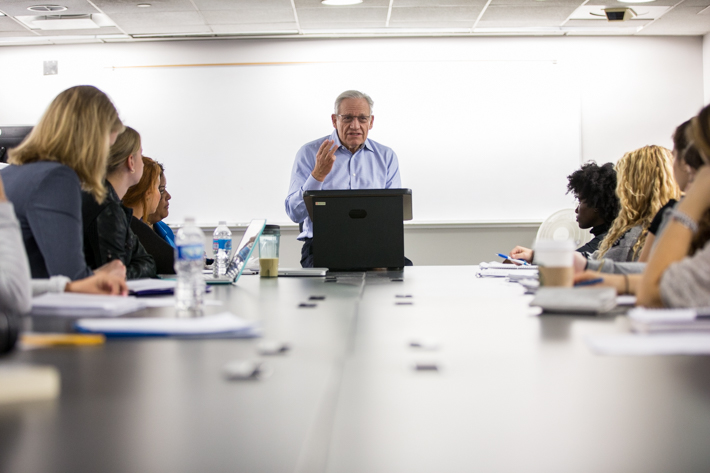There’s a piece of advice that still guides renowned journalist Bob Woodward’s decades-long career as an investigative reporter: Go to the scene.
On Monday, Mr. Woodward passed those words on to George Washington University students. He gave a lecture to an investigative journalism class taught by School of Media and Public Affairs Professor Cheryl W. Thompson, who like Mr. Woodward is a Pulitzer Prize-winning reporter.
The rule has served Mr. Woodward well. The Washington Post former Executive Editor Ben Bradlee once described Mr. Woodward as “the best of his generation” in investigative journalism. Mr. Woodward is now an associate editor of The Post and has written 16 bestsellers, most of them on American politics.
He took students back to his early days at The Post. As a young reporter, he got a scoop that he thought was guaranteed to make front-page news. Someone in the D.C. government’s restaurant inspection section told him that the Mayflower Coffee Shop had received one of the worst scores for health code violations. Assuming the coffee shop was in the historic Mayflower Hotel, Mr. Woodward quickly drafted an article detailing how the luxury hotel had failed sanitation inspections. He handed his work to the Post’s city editor.
The city editor asked Mr. Woodward whether he had visited the coffee shop himself. When Mr. Woodward replied that he had not, his provided terse orders: “its two blocks away. Get off your ass and go there.”
Mr. Woodward arrived at the Mayflower Hotel, where a bewildered employee told him the hotel didn’t own a coffee shop. Mr. Woodward checked the address from his source and realized the failed inspection referred to a coffee shop located half a block away—at a different hotel.
“What’s the lesson here?” Mr. Woodward asked students. “Go to the scene…. There is always a scene to go to. There is always firsthand experience. There is always some document. There are always multiple sources.”
It wasn’t a typical guest lecture. Mr. Woodward has made a career of wangling answers from the most taciturn sources. Rather than simply chronicling stories from his illustrious career, Mr. Woodward urged students to sharpen their own interviewing skills by asking him direct questions.
Professor Thompson’s students have discussed credible sources and interview strategies all semester, and they had spent the previous class poring over the Frost/Nixon interviews. They approached Mr. Woodward armed with queries, eager to get answers from the reporting legend.
“This is a person you read about in your high school history textbooks,” said junior Ali Stagnitta.
Even SMPA Director Frank Sesno dropped into the class, where students asked how Mr. Woodward has developed relationships with inside sources and what strategies get sources talking.
Mr. Woodward shared one method that always helps: silence. He’s found that sometimes, saying absolutely nothing makes sources feel anxious, and in their uneasiness, they begin to chatter away to fill lulls in the conversation. Mr. Woodward even has a signal to remind himself to stop talking—he presses his finger into the nail of his pinky until it hurts to remind himself to let the subject speak.
“In the CIA, they have a term. It’s called ‘let the silence suck out the truth.’ It’s the hardest thing to do—to shut up. It is often the most effective,” Mr. Woodward said.
Mr. Woodward also urged students to make their sources think they are the most important person in the room and advised the class of future reporters to be endlessly fascinated by the people they interview. This detail, he said, makes journalism “the best job in the world.”
“As a reporter, you get to make momentary entries into people’s lives when they’re interesting, and then get out when they cease to be interesting,” he said.


